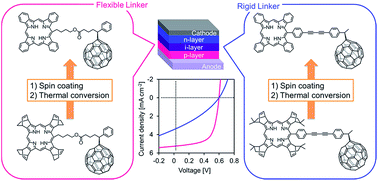Fullerene-linked tetrabenzoporphyrins for solution-processed organic photovoltaics: flexible vs. rigid linkers†
Abstract
Solution processing of a layer-by-layer structure is possible with a precursor approach, in which the soluble precursors of the insoluble or low-solubility target materials are spin-coated on the substrate and converted to insoluble semiconducting films by heating. We attempted to construct a p–i–n structure (p: p-layer; i: interlayer, a mixture of p- and n-materials; n: n-layer) using a solution process. To increase the donor–acceptor interface area, we synthesized covalently linked donor–acceptor compounds, tetrabenzoporphyrin (BP)–fullerene (C60) dyad. To investigate the effect of the covalent connection of the donor and acceptor units on the film morphology and on the OPV performances, the BP and fullerene units were connected by a flexible or rigid linker (f-BP–C60 or r-BP–C60). To synthesize these dyads, new synthetic routes with mono-meso-substituted BPs using [2 + 2] and [2 + 1 + 1] condensation reactions were performed. The intramolecular fluorescence quenching efficiency of BP by the C60 unit of f-BP–C60 was higher than that of r-BP–C60 in CH2Cl2 because of the flexibility of the linker and the close location of the C60 unit to the BP unit. The carrier mobility in the r-BP–C60 film measured by the space-charge-limited-current (SCLC) technique was better than that of the f-BP–C60 film, and the bulk heterojunction (BHJ)-type OPV performance of the r-BP–C60 film was better than that of the f-BP–C60 film. In spite of the superior OPV performance of the r-BP–C60 device compared to the f-BP–C60, the short circuit current density (JSC) and FF of the p–i–n device with BP, f-BP–C60, and [6,6]-phenyl-C61-butyric acid methyl ester (PCBM) for p-, i- and n-layers was better than the device with r-BP–C60 as the i-layer. AFM images of the layers and OPV performances suggested that the flexible f-BP–C60 is suitable for the i-layer on the highly crystalline BP film because the roughness of the BP film is leveled by the f-BP–C60, and the electric properties of the device are improved by the smooth interface.



 Please wait while we load your content...
Please wait while we load your content...